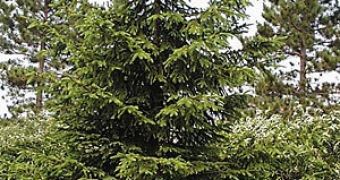This is a real surprise: this cluster of spruces in the mountains in western Sweden, at an age of 8,000 years, may be not only the world's oldest living trees, but also the most aged being on the planet.
The spruces were found growing high on a mountain side, that's why they were protected from logging, but stood harsh clime conditions.
"Carbon dating of the trees carried out at a laboratory in Miami, Florida, showed the oldest of them first set root about 8,000 years ago, making it the world's oldest known living tree," said Professor Leif Kullman of the Umea University.
Another two spruces from the Swedish county of Dalarna were 4,800 and 5,500 years old.
"These were the first woods that grew after the Ice Age. That means that when you speak of climate change today, you can in these (trees) see pretty much every single climate change that has occurred," said Lars Hedlund, responsible for environmental surveys in the county of Dalarna.
"Although a single tree trunk can become at most about 600 years old, the spruces had survived by pushing out another trunk as soon as the old one died. Rising temperatures in the area in recent years had allowed the spruces to grow rapidly, making them easier to find in the rugged terrain. For quite some time they have endured as bushes maybe 0.5 m (1.6 ft) tall. But over the past few decades we have seen a much warmer climate, which has meant that they have popped up like mushrooms in the soil," said Kullman.
Coniferous trees have been known as the champions of lifespan on Earth. Their slow metabolism, efficient resins against pathogens and dry-resistant adaptations seem to have brought them success.
Previously, the oldest still living individuals were found to belong to two pine species from the mountains of southwestern USA (Utah, Nevada, Eastern California, Colorado, Northern New Mexico, Arizona): Great Basin Bristlecone Pine (Pinus longaeva) and Rocky Mountains Bristlecone Pine (Pinus arista). The oldest individual of Pinus longaeva was found to be 4,900 years old. When the Egyptian civilization was emerging, these pines were seedlings.
Still, the pines are dwarfs compared to the Norway spruce (which grows up to 60 m (200 ft) in height): they hardly reach 15 m (45 feet); 3.6 (11 feet) in diameter. Their growth is very slow: 2,5 cm (one inch) per century. And their leaves are the most longevous known: till 45 years.
The wood of these trees is currently half dead, but it does not decompose due to the dry, cold climate in which they live, at 2,500-3,700 m (7,500-11,100 feet) altitude. In fact, the climate and the durability of their wood can preserve them long after death, with dead trees as old as 7,000 years persisting next to living ones. Tree growth rings can record the climate of a year (wet years produce thicker rings, dry years thinner ones). The rings of these pines showed us the climate of the last five millennia in southwestern US: after a warm and wet period, following the glaciations, 2500 years ago, temperatures decreased and so did the rainfalls. 1000 years ago, a warm and dry period, which still persists, installed.

 14 DAY TRIAL //
14 DAY TRIAL //